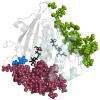Elucidation of the conformational free energy landscape in H.pylori LuxS and its implications to catalysis
- PMID: 20704697
- PMCID: PMC2929236
- DOI: 10.1186/1472-6807-10-27
Elucidation of the conformational free energy landscape in H.pylori LuxS and its implications to catalysis
Abstract
Background: One of the major challenges in understanding enzyme catalysis is to identify the different conformations and their populations at detailed molecular level in response to ligand binding/environment. A detail description of the ligand induced conformational changes provides meaningful insights into the mechanism of action of enzymes and thus its function.
Results: In this study, we have explored the ligand induced conformational changes in H.pylori LuxS and the associated mechanistic features. LuxS, a dimeric protein, produces the precursor (4,5-dihydroxy-2,3-pentanedione) for autoinducer-2 production which is a signalling molecule for bacterial quorum sensing. We have performed molecular dynamics simulations on H.pylori LuxS in its various ligand bound forms and analyzed the simulation trajectories using various techniques including the structure network analysis, free energy evaluation and water dynamics at the active site. The results bring out the mechanistic details such as co-operativity and asymmetry between the two subunits, subtle changes in the conformation as a response to the binding of active and inactive forms of ligands and the population distribution of different conformations in equilibrium. These investigations have enabled us to probe the free energy landscape and identify the corresponding conformations in terms of network parameters. In addition, we have also elucidated the variations in the dynamics of water co-ordination to the Zn2+ ion in LuxS and its relation to the rigidity at the active sites.
Conclusions: In this article, we provide details of a novel method for the identification of conformational changes in the different ligand bound states of the protein, evaluation of ligand-induced free energy changes and the biological relevance of our results in the context of LuxS structure-function. The methodology outlined here is highly generalized to illuminate the linkage between structure and function in any protein of known structure.
Figures








Similar articles
-
An active site water broadens substrate specificity in S-ribosylhomocysteinase (LuxS): a docking, MD, and QM/MM study.J Phys Chem B. 2012 Aug 2;116(30):8916-29. doi: 10.1021/jp3049907. Epub 2012 Jul 13. J Phys Chem B. 2012. PMID: 22742766
-
The 1.2 A structure of a novel quorum-sensing protein, Bacillus subtilis LuxS.J Mol Biol. 2001 Oct 12;313(1):111-22. doi: 10.1006/jmbi.2001.5027. J Mol Biol. 2001. PMID: 11601850
-
Functional correlation of bacterial LuxS with their quaternary associations: interface analysis of the structure networks.BMC Struct Biol. 2009 Feb 25;9:8. doi: 10.1186/1472-6807-9-8. BMC Struct Biol. 2009. PMID: 19243584 Free PMC article.
-
Mechanism of action of S-ribosylhomocysteinase (LuxS).Curr Opin Chem Biol. 2004 Oct;8(5):492-7. doi: 10.1016/j.cbpa.2004.08.003. Curr Opin Chem Biol. 2004. PMID: 15450491 Review.
-
Establishing bacterial communities by 'word of mouth': LuxS and autoinducer 2 in biofilm development.Nat Rev Microbiol. 2008 Aug;6(8):635-43. doi: 10.1038/nrmicro1916. Epub 2008 Jun 9. Nat Rev Microbiol. 2008. PMID: 18536728 Review.
Cited by
-
Allosteric regulation of the Hsp90 dynamics and stability by client recruiter cochaperones: protein structure network modeling.PLoS One. 2014 Jan 20;9(1):e86547. doi: 10.1371/journal.pone.0086547. eCollection 2014. PLoS One. 2014. PMID: 24466147 Free PMC article.
-
Molecular Aspects of the Functioning of Pathogenic Bacteria Biofilm Based on Quorum Sensing (QS) Signal-Response System and Innovative Non-Antibiotic Strategies for Their Elimination.Int J Mol Sci. 2024 Feb 24;25(5):2655. doi: 10.3390/ijms25052655. Int J Mol Sci. 2024. PMID: 38473900 Free PMC article. Review.
-
S-Ribosylhomocysteine Analogues Modified at the Ribosyl C-4 Position.J Sulphur Chem. 2016;37(3):307-327. doi: 10.1080/17415993.2015.1137921. Epub 2016 Feb 24. J Sulphur Chem. 2016. PMID: 27516805 Free PMC article.
-
Differential modulation of functional dynamics and allosteric interactions in the Hsp90-cochaperone complexes with p23 and Aha1: a computational study.PLoS One. 2013 Aug 19;8(8):e71936. doi: 10.1371/journal.pone.0071936. eCollection 2013. PLoS One. 2013. PMID: 23977182 Free PMC article.
-
Computational Analysis of Residue Interaction Networks and Coevolutionary Relationships in the Hsp70 Chaperones: A Community-Hopping Model of Allosteric Regulation and Communication.PLoS Comput Biol. 2017 Jan 17;13(1):e1005299. doi: 10.1371/journal.pcbi.1005299. eCollection 2017 Jan. PLoS Comput Biol. 2017. PMID: 28095400 Free PMC article.
References
Publication types
MeSH terms
Substances
LinkOut - more resources
Full Text Sources

